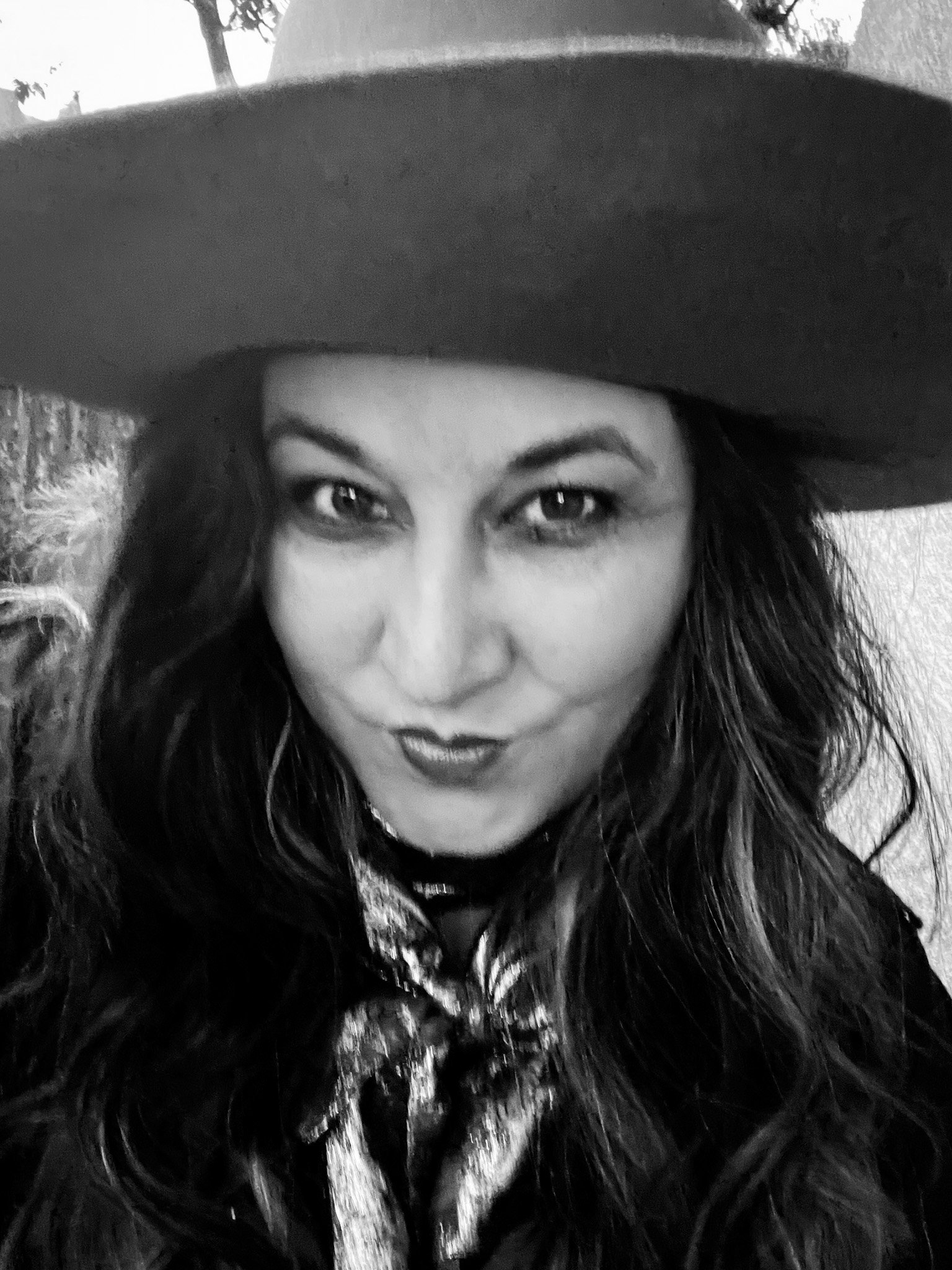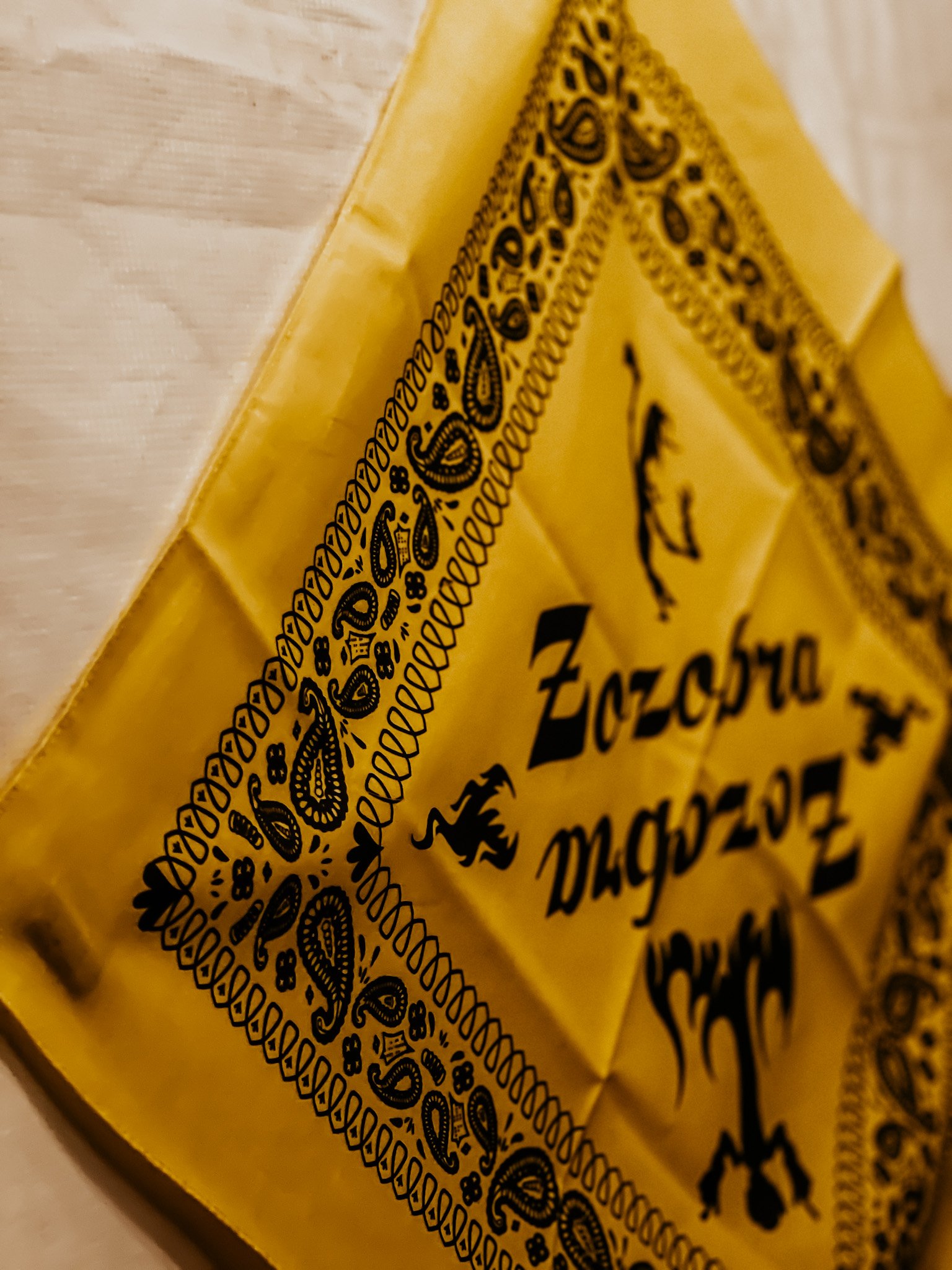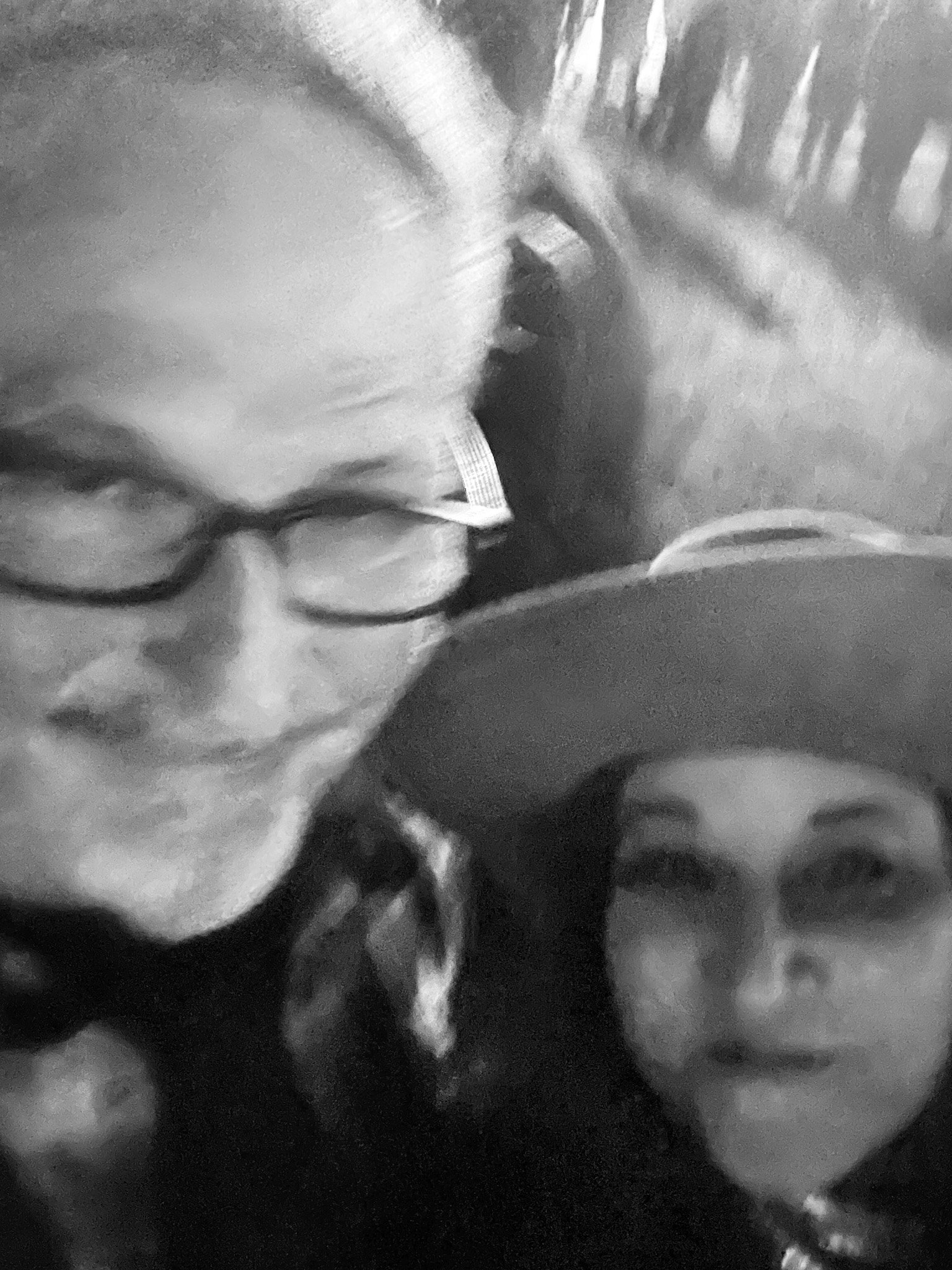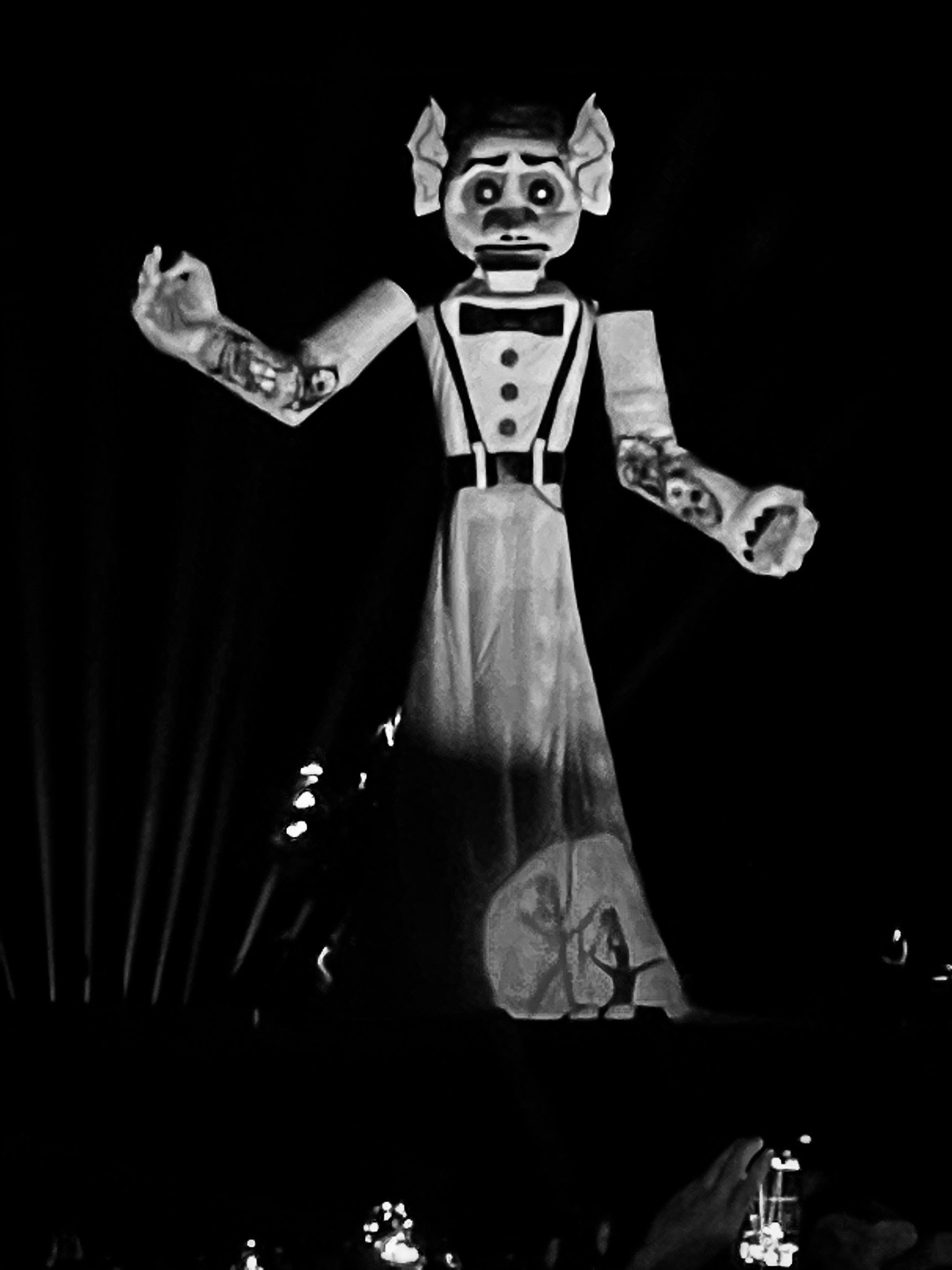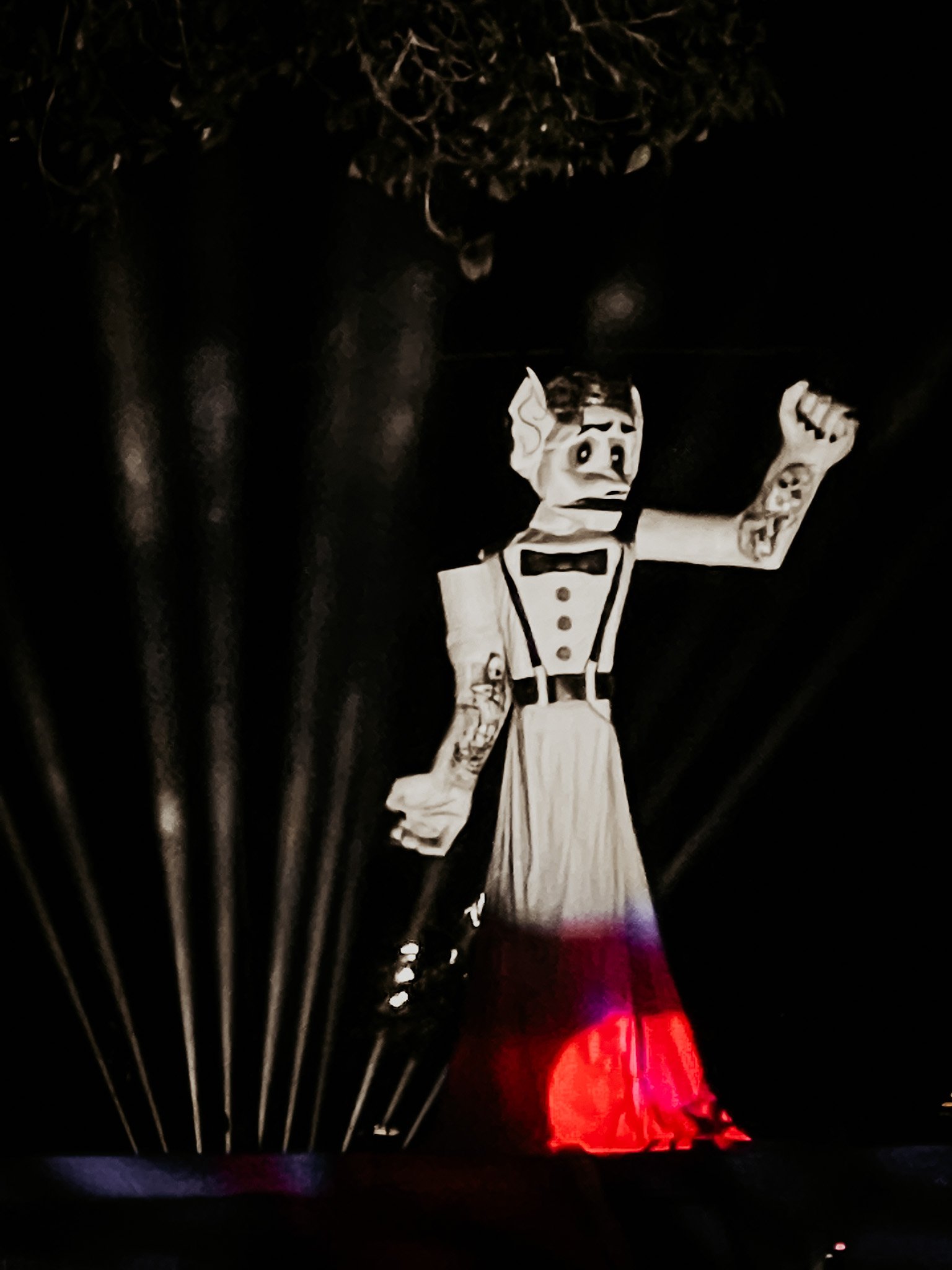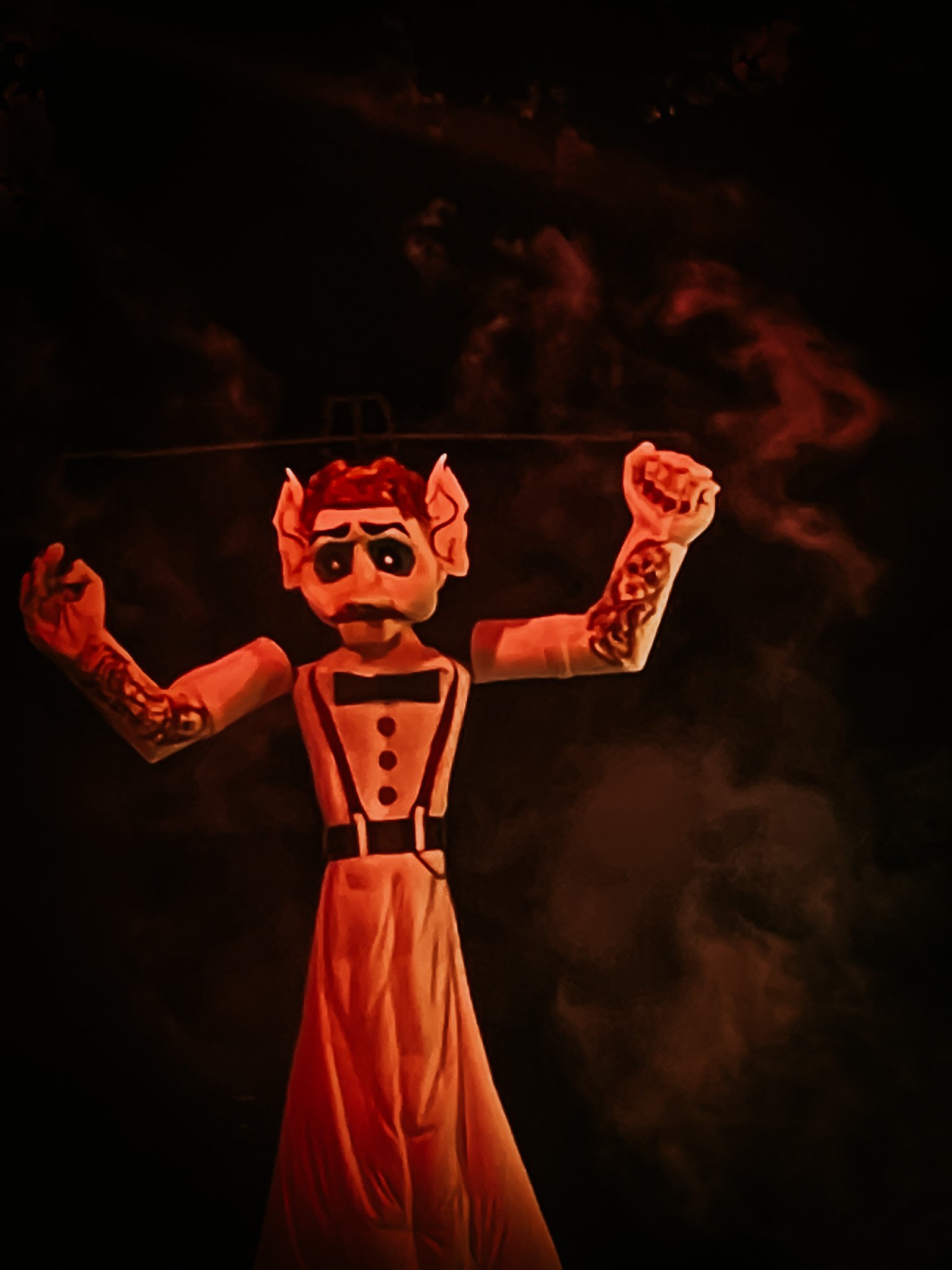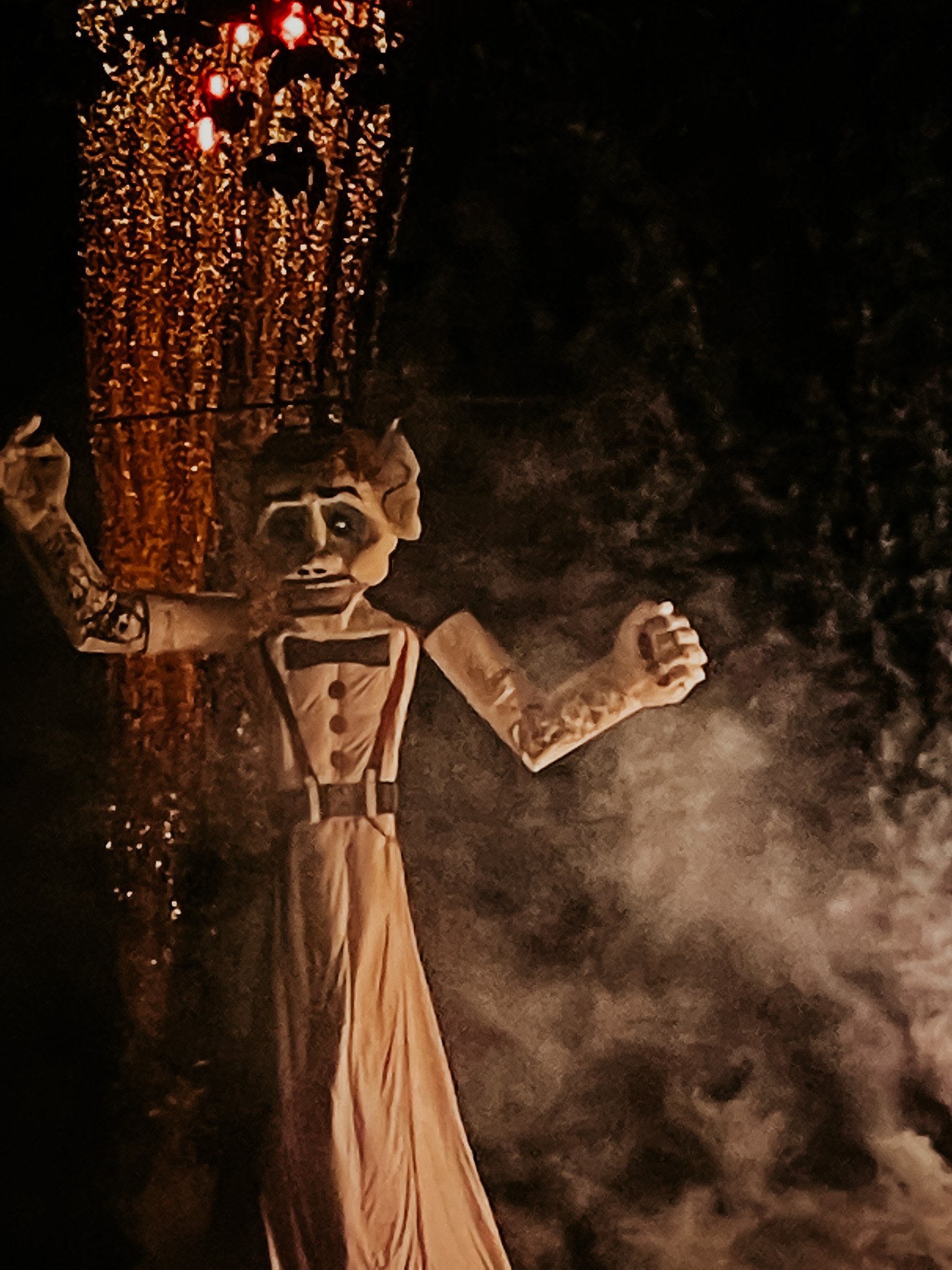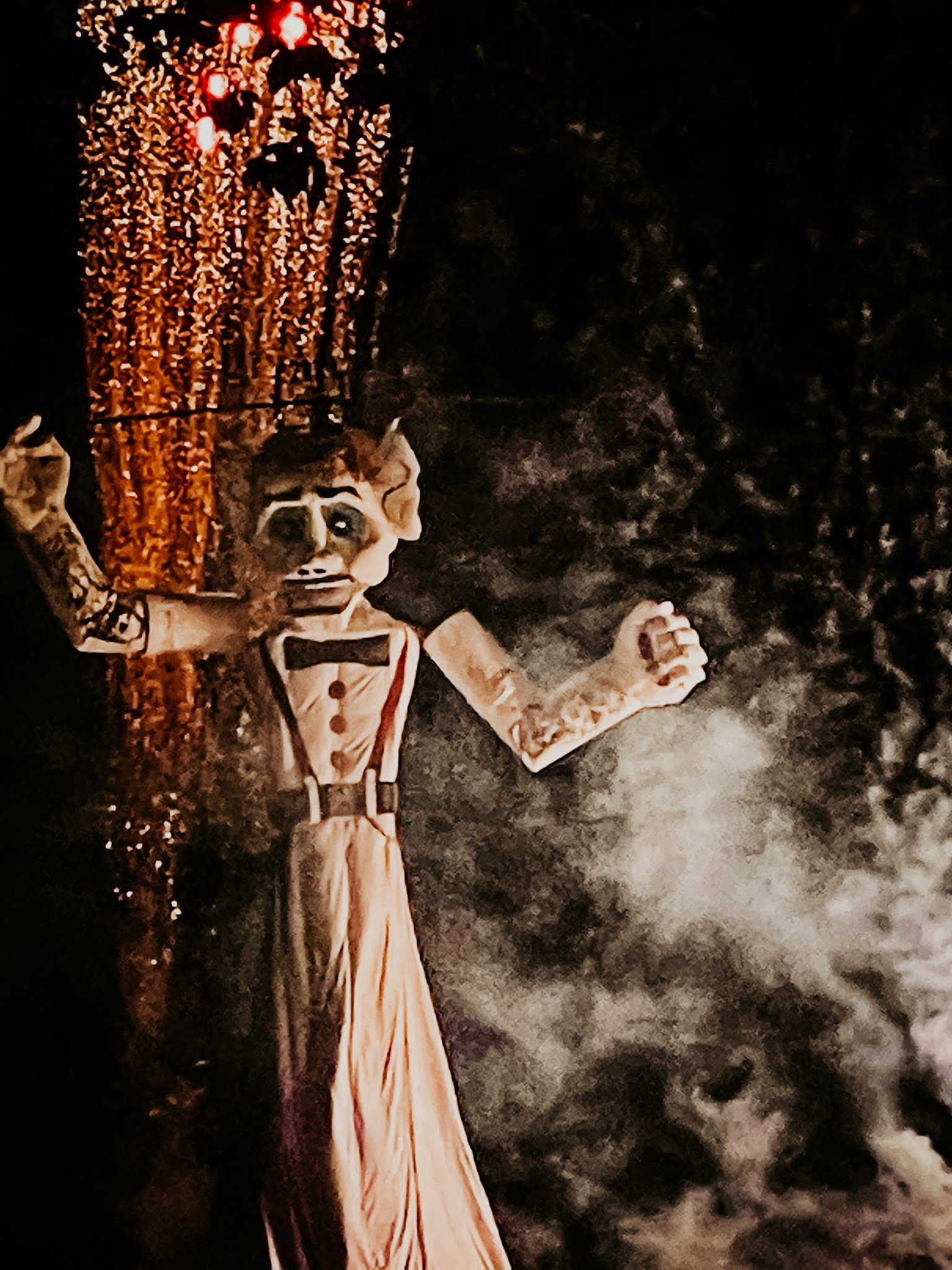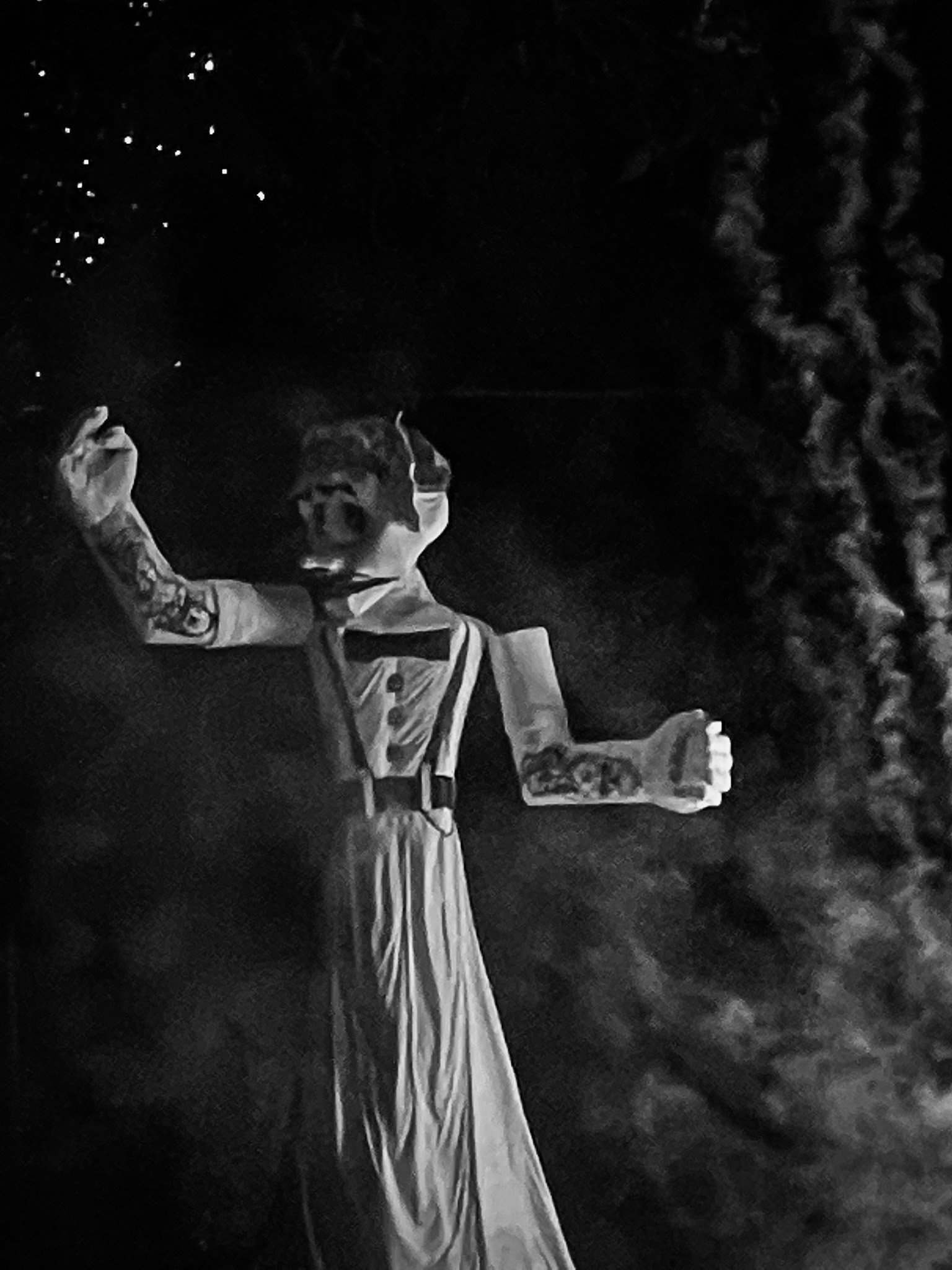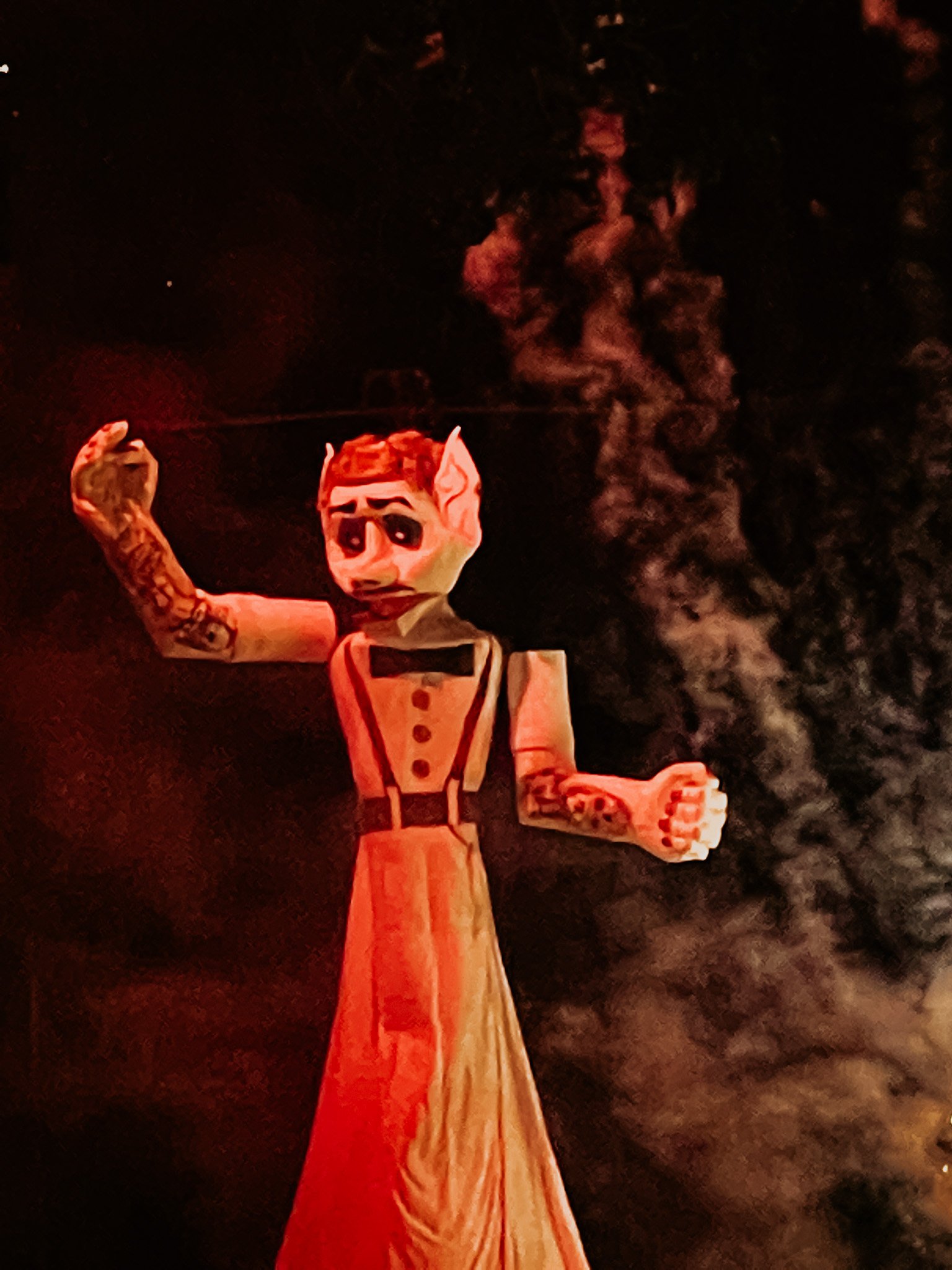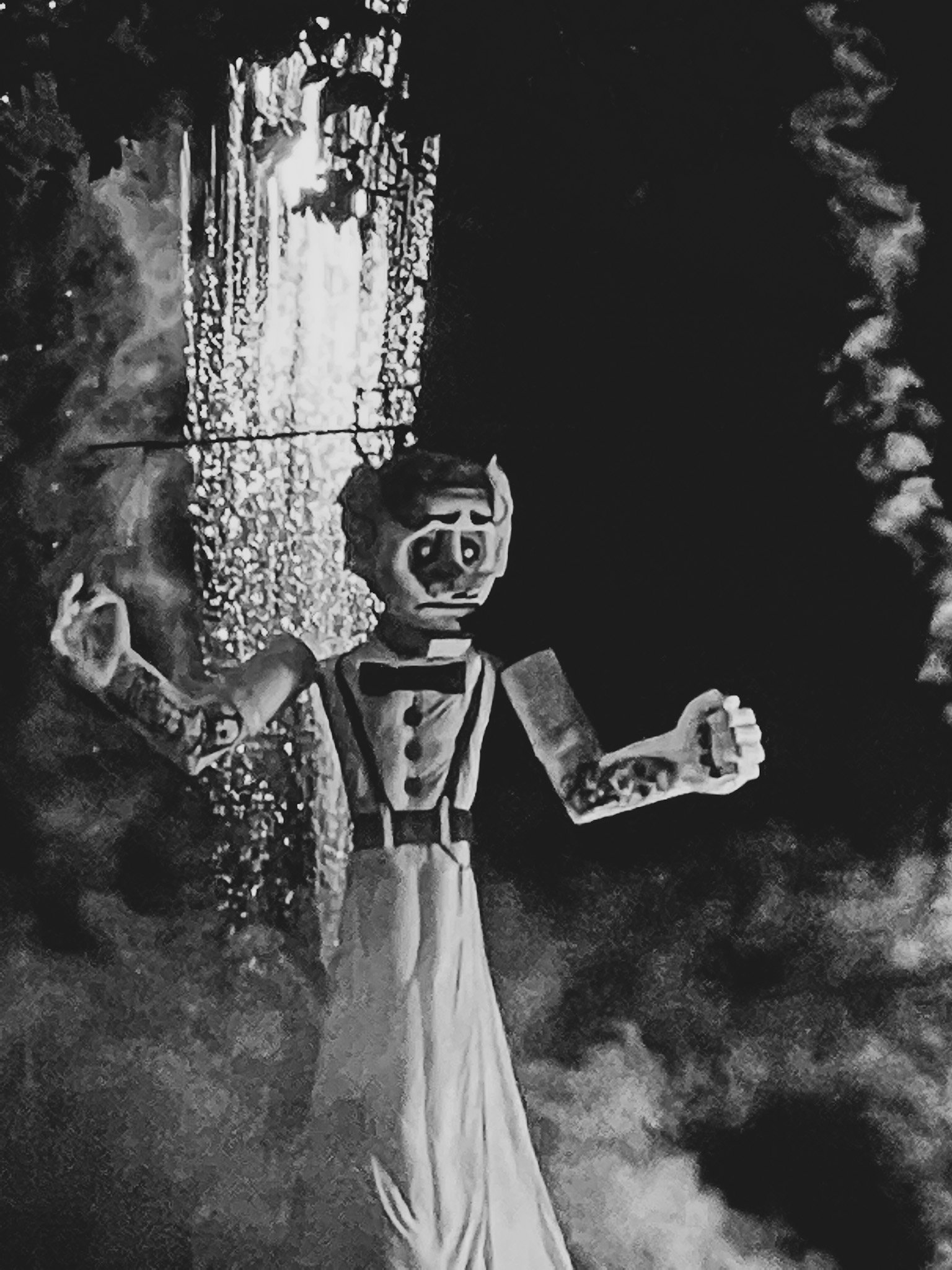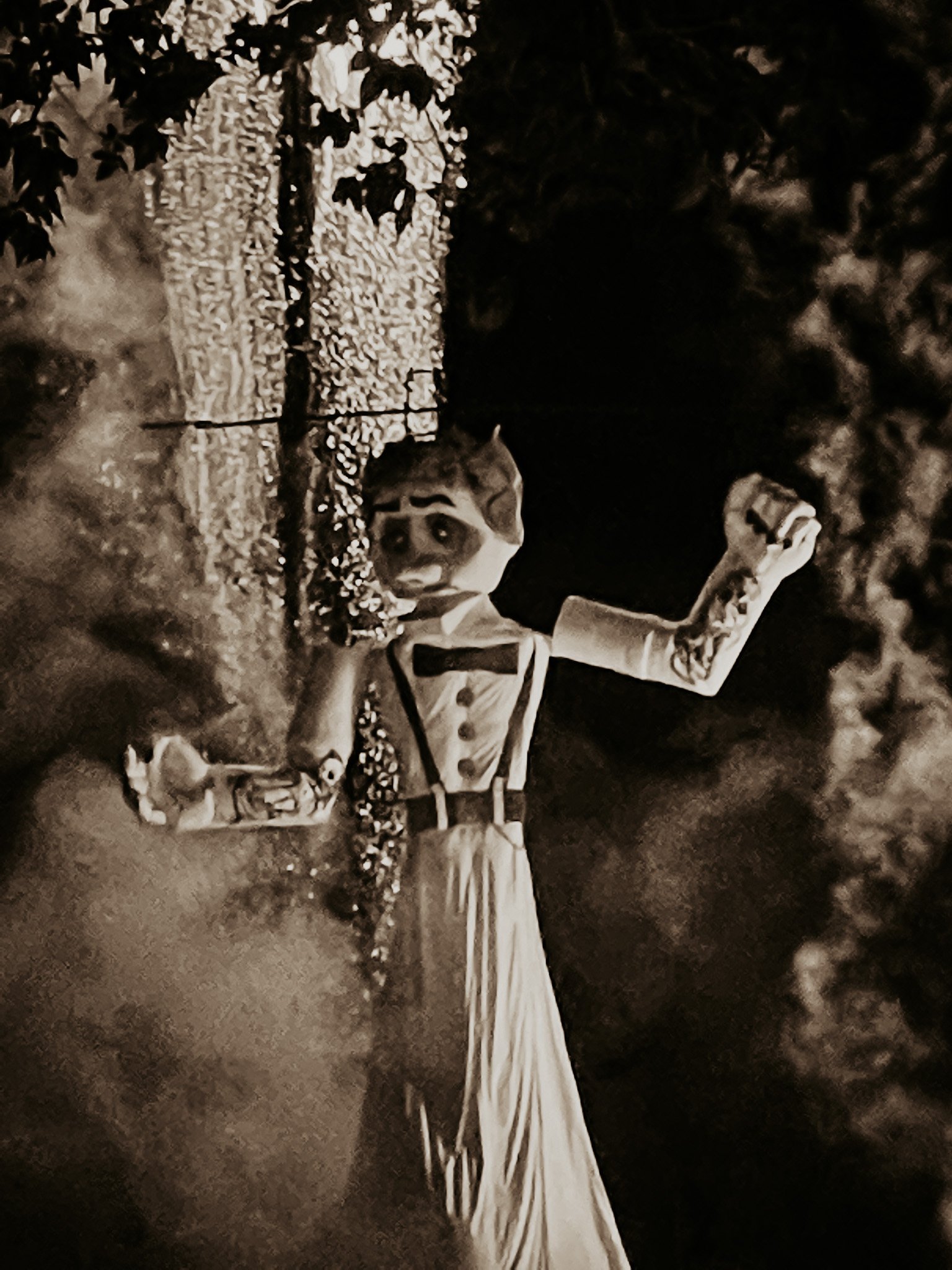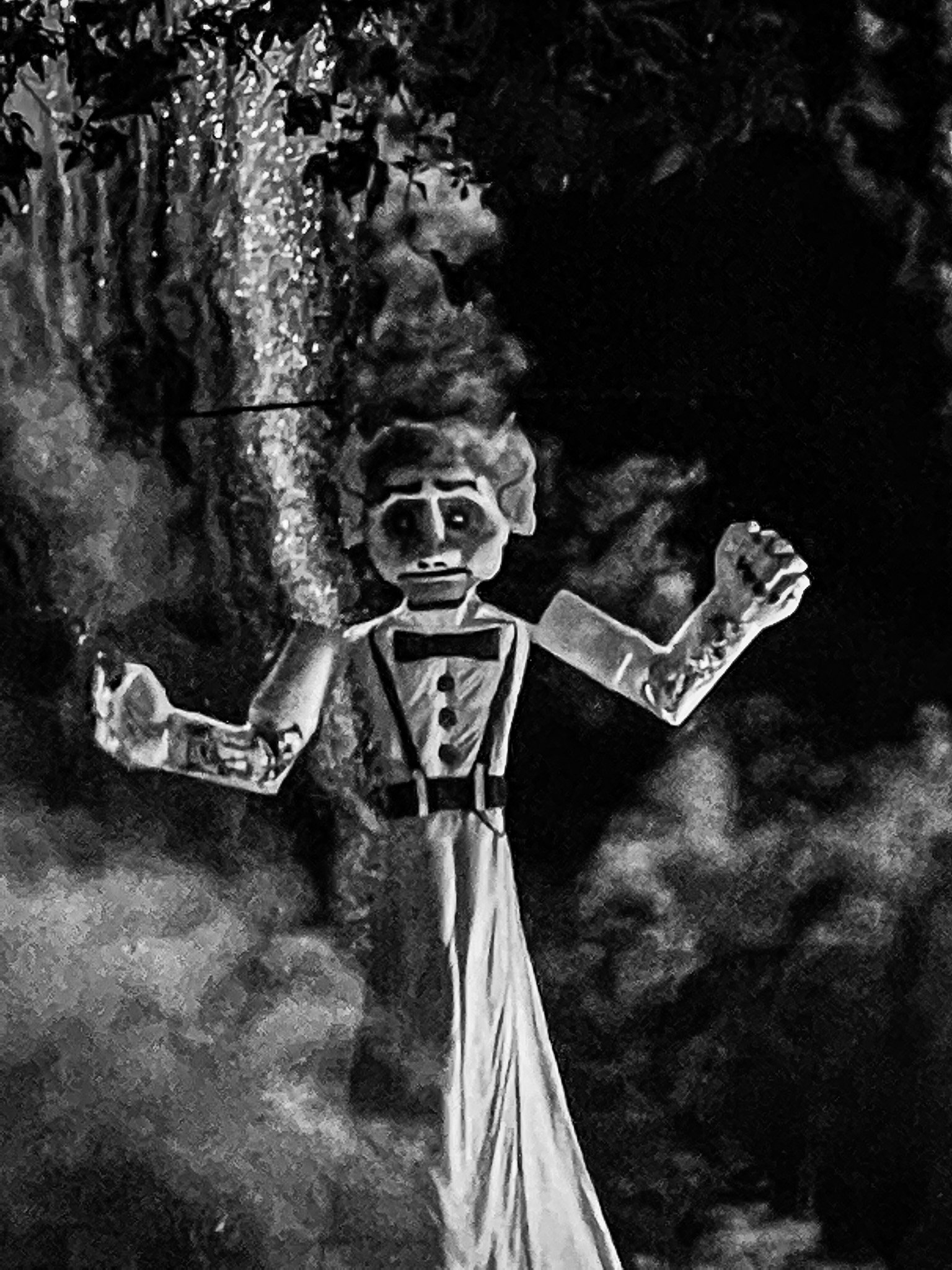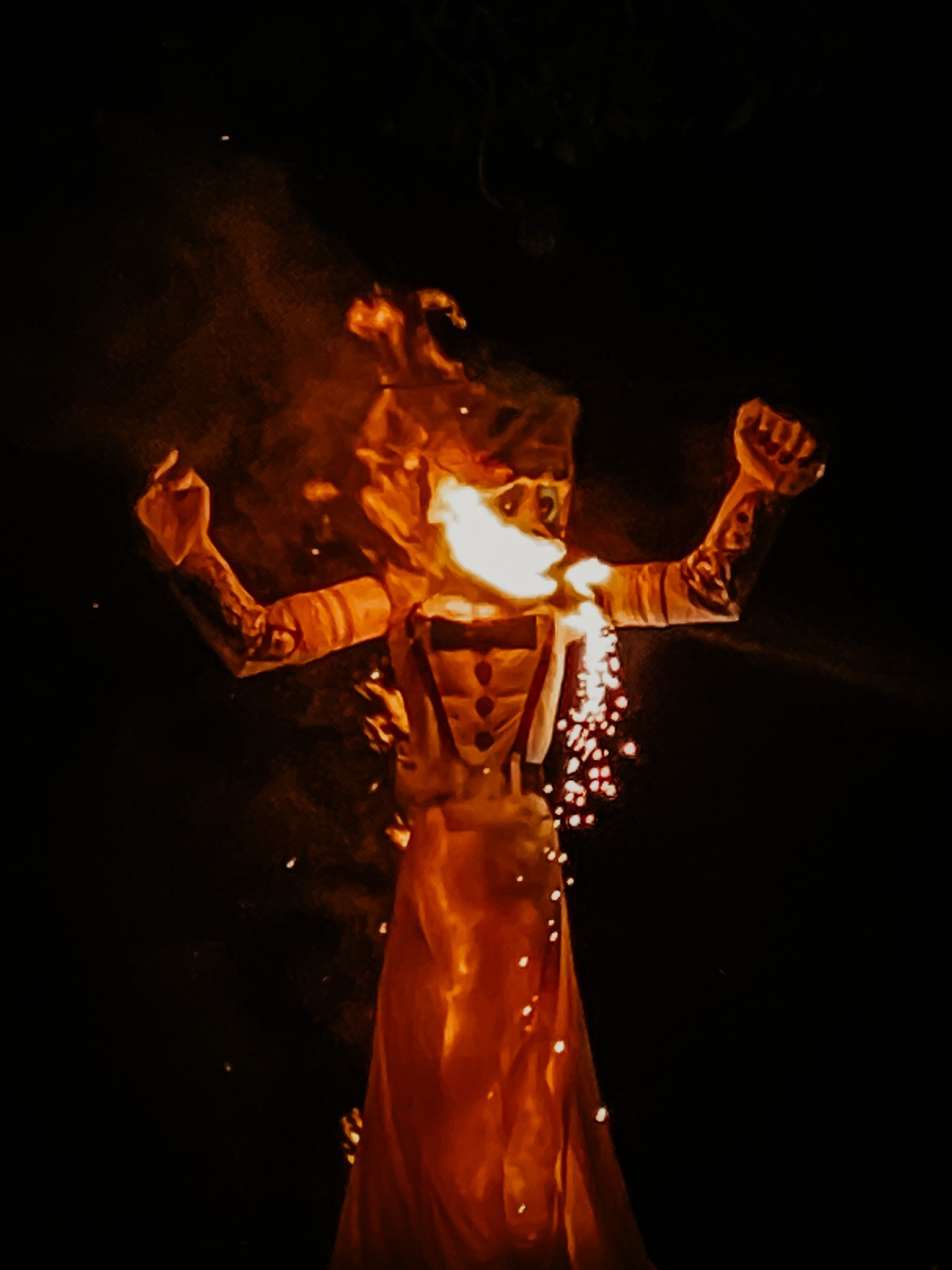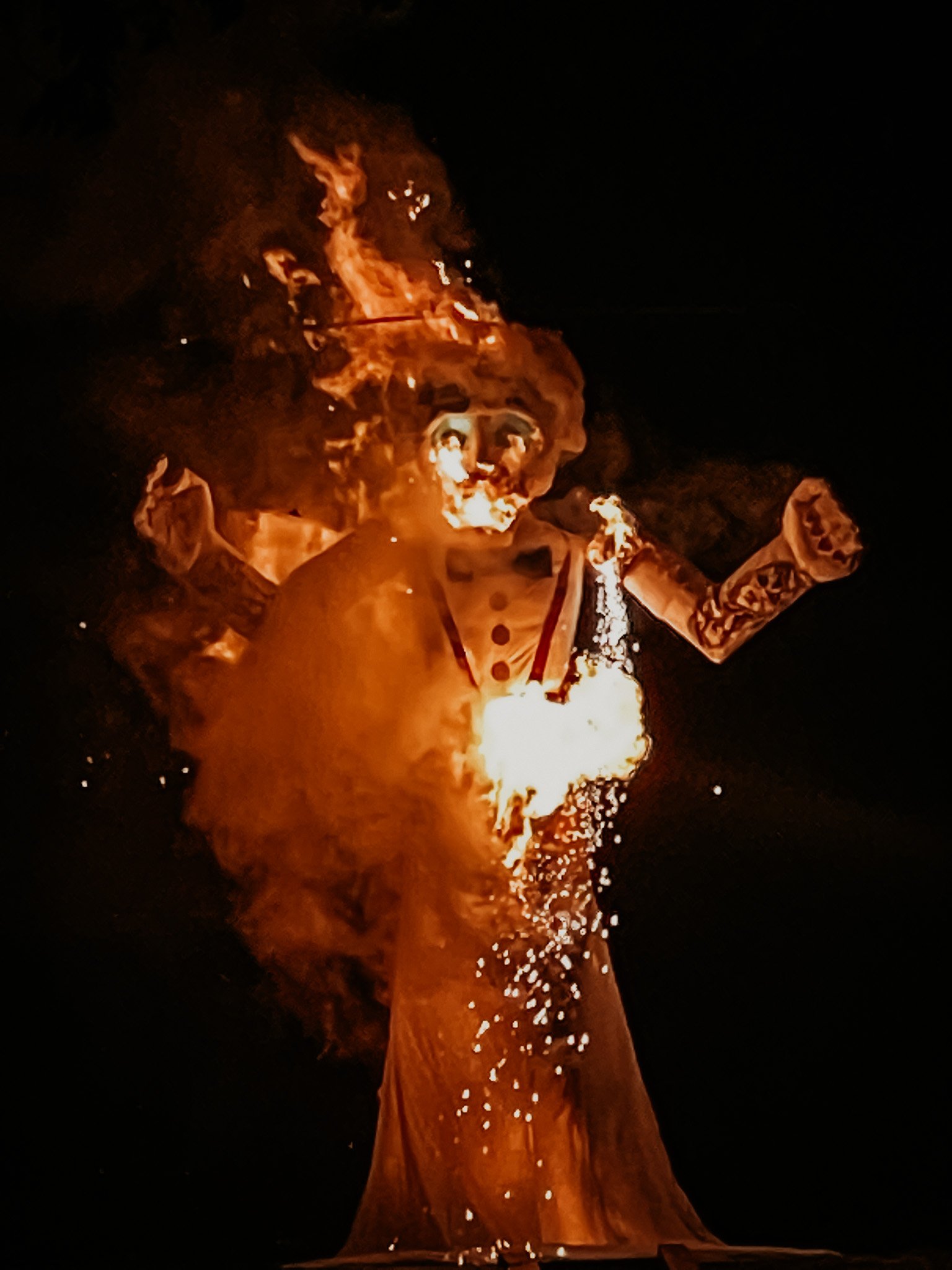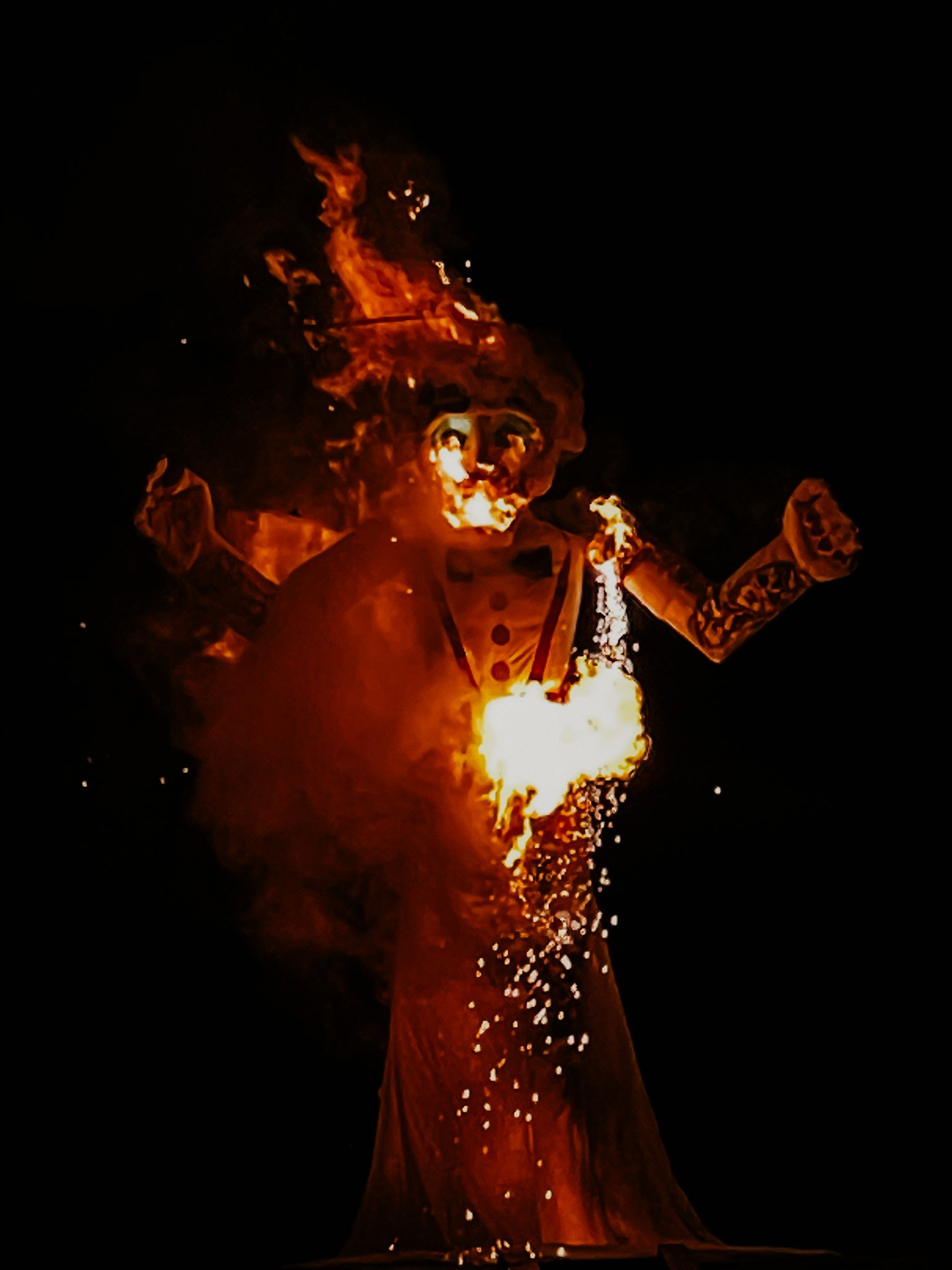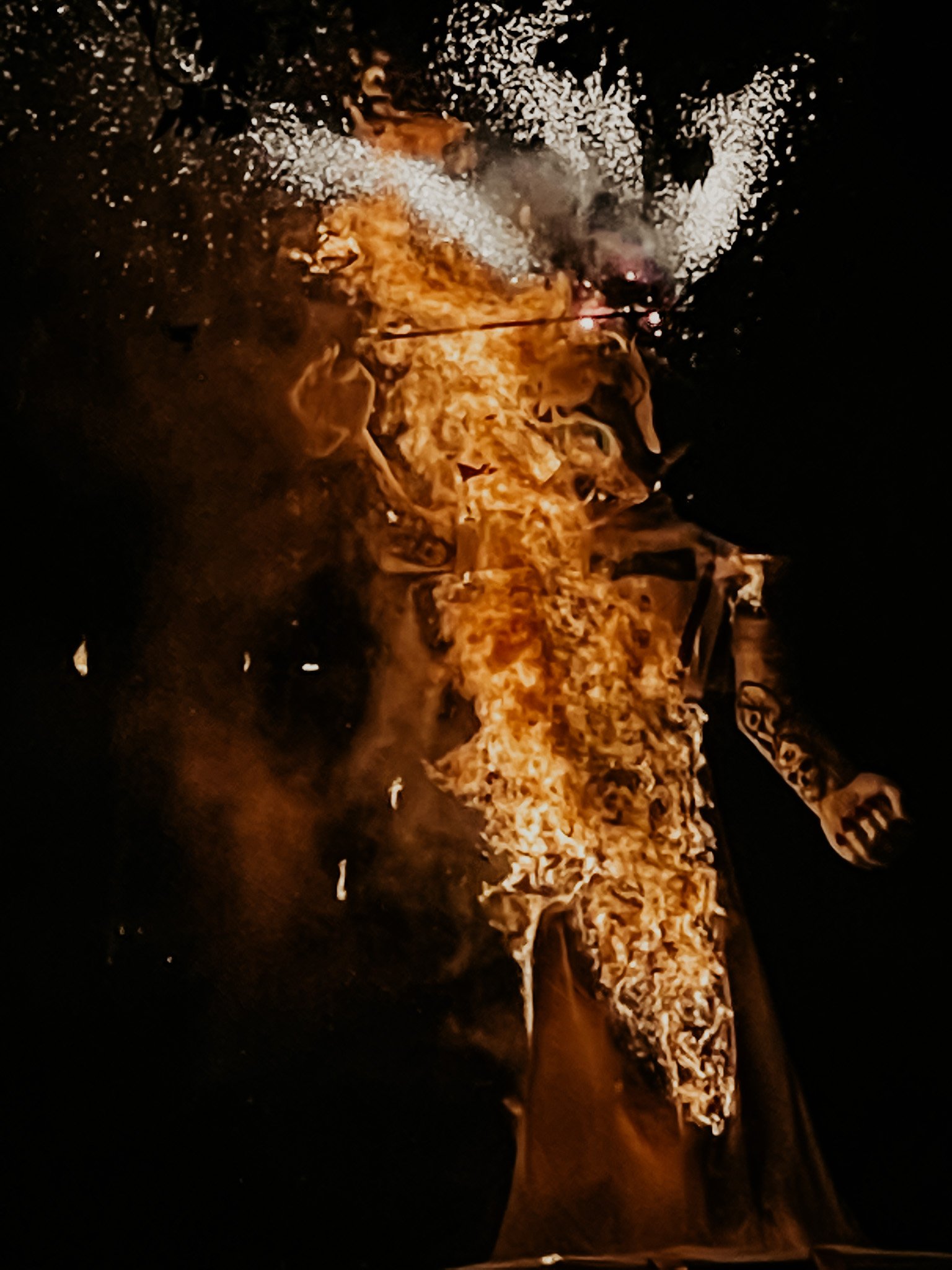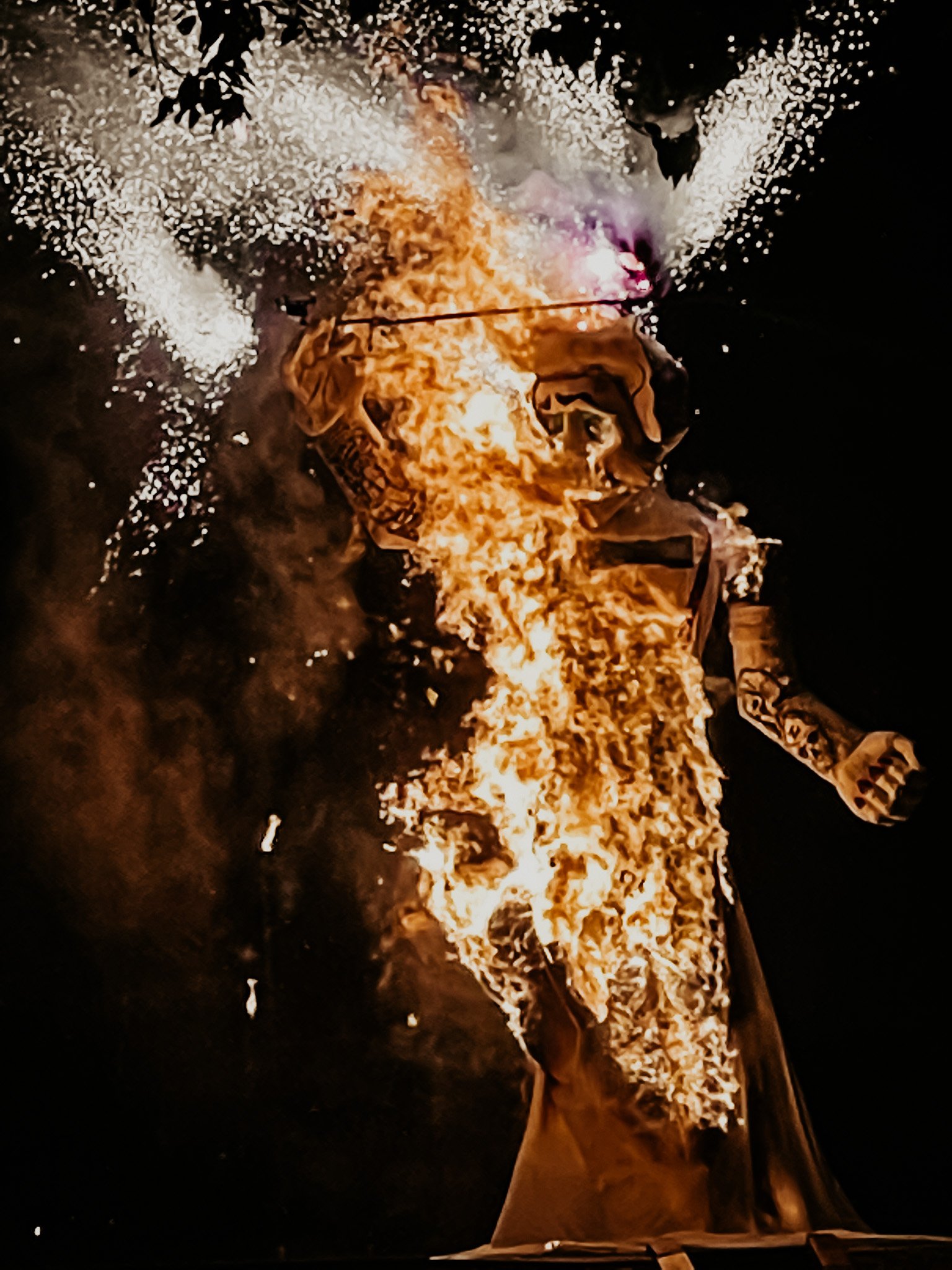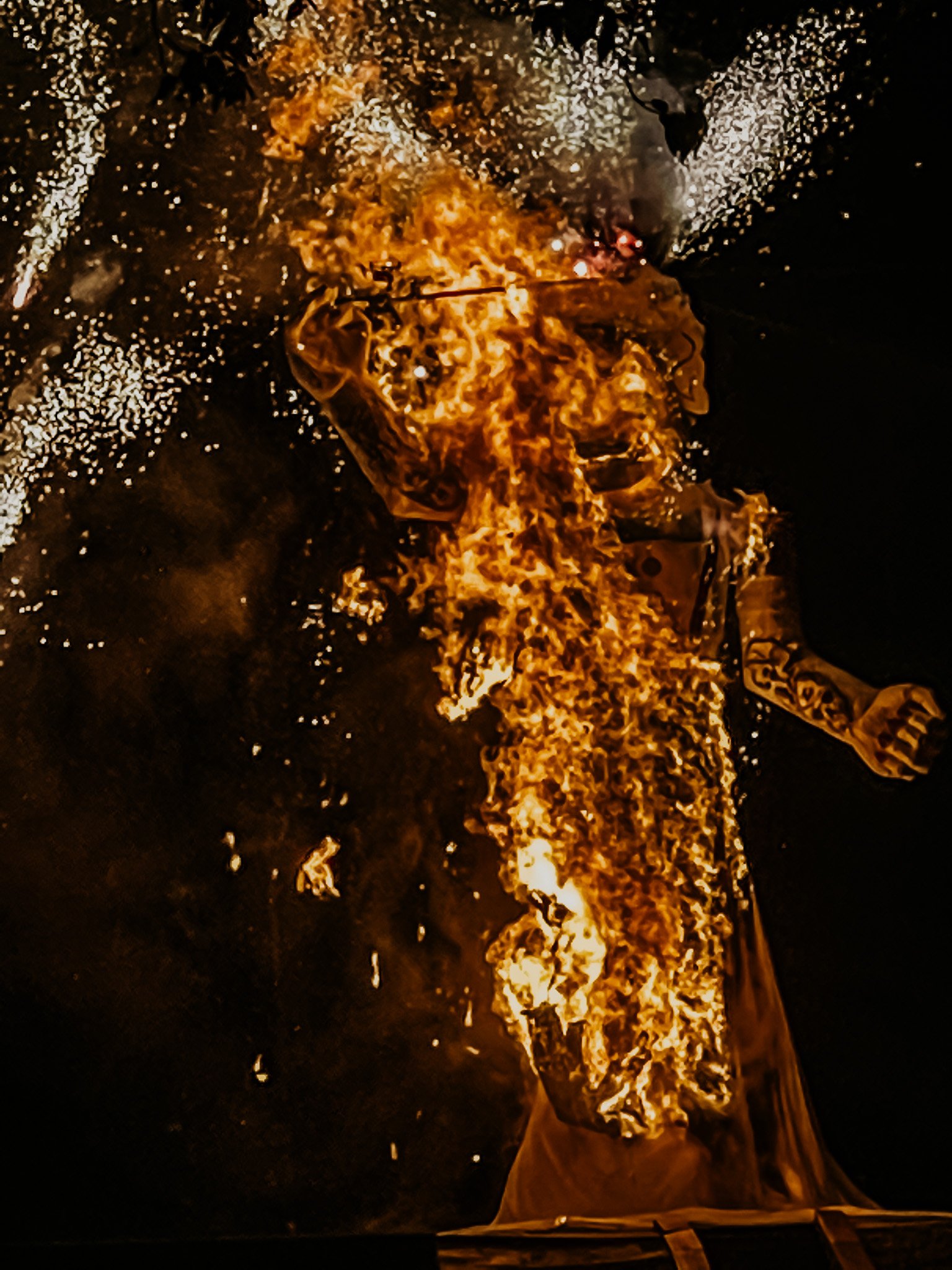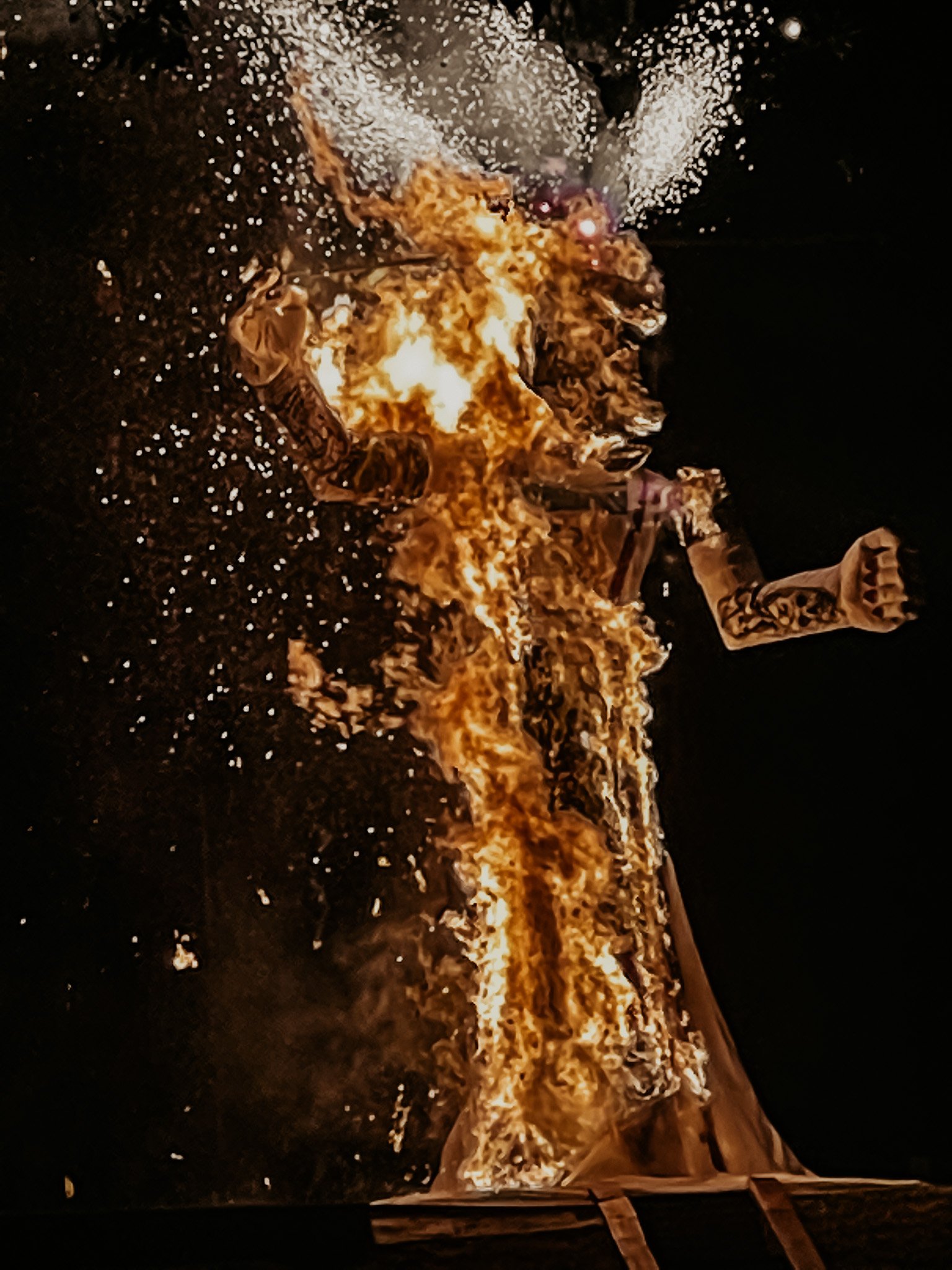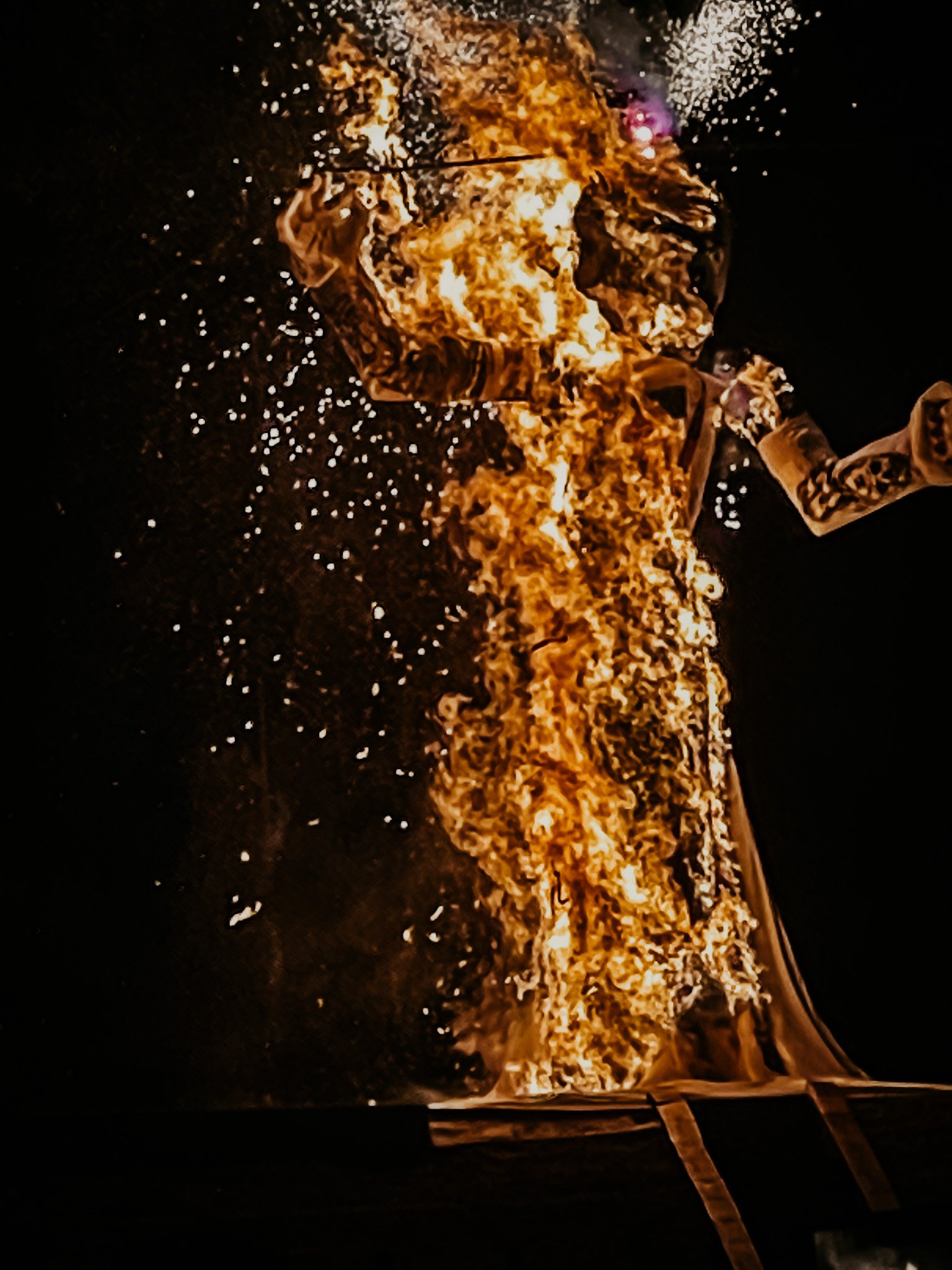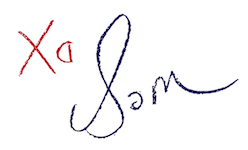My First Zozobra Experience
ALL ABOUT ZOZOBRA
What –– or
Who –– Is Zozobra?
The Burning of Zozobra is a unique cultural event staged annually by the Kiwanis Club of Santa Fe on the Friday of Labor Day weekend as an exciting and fiery finale to the last days of summer. And video is more your thing…here you go!!
Zozobra is the creation of Will Shuster, one of Los Cinco Pintores, a group of artists who made their way to New Mexico in the 1920s. Shuster’s creation first burned in his backyard in 1924 as a 6-foot effigy, and over the years, has grown to a towering 50-foot high marionette. Made of wood, wire and cotton cloth and stuffed with hundreds of bags of shredded paper, Zozobra is a dark and eerie character, part ghost and part monster. Since those early days, the people of Santa Fe, families and friends new and old, have annually made their way to Fort Marcy Park, a few blocks from the historic Santa Fe Plaza, to view this one-of-a-kind Labor Day Friday pageant.
The Kiwanis Club of Santa Fe became the Zozobra pageant officials when creator, artist Will Shuster, assigned all rights to the Club in 1964. To this day, the Club retains all the exclusive copyrights and trademarks to the figure. As the major fundraiser for the Santa Fe Kiwanis Club, Zozobra has become a welcome and entertaining opportunity for the citizens of Santa Fe –– and visitors from around the globe –– to participate in a community service event that benefits children via grants and fun educational activities.
The Mythology of Zozobra
Zozobra is the enemy of all that is good, and Santa Fe knows only too well the spell of darkness and despair that Zozobra casts annually over the City.
This doom-and-gloom specter is recreated annually because of our own nefarious and woeful deeds throughout the year. In order to lure Zozobra out of hiding, the city leaders invite him to a party he believes is being held in his honor. With his enormous ego urging him on, Zozobra accepts this invitation, recognizing it as his best opportunity to invade the heart of town, destroy all hope and happiness, and rob the city of its most precious possession, its hope.
Zozobra appears at Fort Marcy Park, just north of Santa Fe’s heart –– the Plaza –– at the appointed hour dressed in his black-tie attire. Eager to embark upon his sinister plans, Zozobra becomes disgruntled as he’s kept waiting to be honored. While townsfolk gather, Zozobra casts a spell over Santa Fe’s children of Santa Fe, driving hope and happiness from their minds and replacing it with gloom and despair –– they become his minions, the Gloomies. Zozobra realizes the citizens had lured him to this fraudulent party to capture him, and he commands his now-faithful army of Gloomies to wreak havoc on the city. The Gloomies begin to enact his wicked plan, but a group of brave torch-bearing townsfolk arrives to challenge the gloom. As if waking from a nightmare, the Gloomies scatter at the sight of the bright light from the torches.
Growling in fury,, Zozobra chases the torchbearers away, but his victory is short-lived as the crowd begins the age-old cry, “Burn him!” Called forth by the crowd ‘s goodwill, Zozobra’s eternal foe, the Fire Spirit, materializes from the collective hopes, dreams and faith of Santa Fe’s citizens. Once summoned, the Fire Spirit battles in the darkness to vanquish Santa Fe’s oldest malcontent. Tthe Fire Spirit dances, with famling torches tormenting Zozobra, who shakes his arms in rage, glaring balefully down at his enemy. The crowd’s fervent desire to see the monster defeated is realized as the Fire Spirit sets Zozobra alight in a towering blaze of fire and smoke.
Under a sky lit by celebratory fireworks, the flames consume Zozobra, and he collapses at last into a smoking pile of embers. The crowd dances joyfully as happiness and hope return to the city and state of Santa Fe, New Mexico. Having vanquished gloom for yet another year, the Fire Spirit disappears into the starry night. But alas, gloom will rise again out of man’s failings, faults, and failures to accumulate in the next year’s Zozobra. And once again, the Fire Spirit must be summoned to overcome gloom in an ageless dance that mirrors the eternal struggle between darkness and light.
The History of Zozobra
Artist William Howard Shuster, Jr. created the first Zozobra in 1924 as the signature highlight of a private party for artists and writers in the Santa Fe area. He was inspired by the Holy Week celebrations of the Yaqui Indians of Mexico, in which an effigy of Judas, filled with firecrackers, is led around the village on a donkey, and ultimately set alight. Shuster and his friend, E. Dana Johnson, editor of the local newspaper, came up with the name Zozobra, which in Spanish means to “anguish, anxiety, gloom.”
The artistic locals of the 1920s era had created a new fun and festive event that they called Pasatiempo. In addition to torching their effigy, Shuster and his fun-loving pals came up with the notion of dressing their pets in costume and parading them around the Plaza, along with a spoof of telling local events that had taken place over the past year.
It’s important to know that although Zozobra has been burned annually since 1924, he is most definitely not a martyr. He is a specter whose greatest pleasure is accumulating all the woes and anxieties of the year in order to cast a spell of anguish and sorrow over people’s’ lives. He is renowned as a trouble-maker and sheep-stealer, working diligently to plague the citizens of Santa Fe with feelings of doom and gloom. He has no family to call his own but has been known to refer to his creator, Will Shuster, as Papa Shuster.
Shuster personally oversaw the construction of the Zozobra figure until 1964, when he gave his detailed model and an archive of drawings and scripts to the Kiwanis Club of Santa Fe for their successful continuation of this historic tradition.
In an interview, Shuster commented on one reason for his continuing interest in producing the annual Zozobra show:
“… the look in the youngsters’ faces as they saw this monster who might have stepped out of a fairy tale go up in smoke. That is a reason for Zozobra. He appeals to the childish fancy – in all of us. It is a scene from a fairy tale of our own making.”
A gigantic wood, wire and cloth effigy, Zozobra is one of the world’s largest functioning marionettes, able to wave his arms and move his head, using his mouth to growl ominously prior to meeting his demise. His arch-enemy, the Fire Spirit, dressed in a flowing red costume and headdress, is armed with a pair of blazing torches with which to end Zozobra’s reign of terror. The role of the Fire Spirit was originated by Jacques Cartier, former New York City ballet dancer and local dance teacher, who performed for an amazing 37 years. Cartier was succeeded by one of his students, James Lilienthal, who took over the Fire Spirit role in 1970, performing it for over 30 years and passing the role on to his daughter. Today, this coveted role is held by Santa Fe native, dancer Helene Luna.
Cartier talked about his experience over years spent as the Fire Dancer. “It damn near killed me half a dozen times,” he said, “and I even broke both my ankles; thank God, not at the same time.” Cartier noted that, “The idea of Zozobra grew out of a gang of Santa Fe deep-thinkers who met in something called ‘Society of Quien Sabe.’ They met once a month and membership was based on how well you could tell yarns.”
2The Decades Project
Beginning in 2014, the Kiwanis Club of Santa Fe embarked on an ambitious decades-long program that will culminate with the 100th anniversary of the Burning of Zozobra in 2024.
The Decades Project, a 10-year journey through each of the successive decades of Zozobra’s history since his creation in 1924, is “a great way to relive and celebrate our history and culture, and the educational opportunities for our schools, educators and youth are limitless,” says Ray Sandoval, Zozobra Event Chairman. During each successive year of the Decades Project, the Santa Fe Kiwanis Club recreates Zozobra by designing the event to evoke the style and substance of each individual decade, with that era’s music, art and pop culture interjected into all the fun.
In 2014, when this signature project began, the focus was on the 1920s––the Roaring 20’s–– and in 2015, on the 1930s Depression Era. In 2016, Zozobra designs embraced the World War II era, and 2017 brought him smack dab into the middle of the Mad Men 1950s. 2018 saw Zozobra encountering the peace and love era of the 1960s. 2019 marked the disco era of the 1970s, and Zozobra boogied down with the best of them!
In 2020, the Decades Project was on hiatus due to the unlikely conjunction of Zozobra and the coronavirus, an unprecedented moment that required its own acknowledgement. And what an acknowledgement it was! Zozobra’s head was crowned with red triangles, orange ping-pong balls and silvery shred so his hair represented COVID-19, and his buttons were marked 2020 for the unhappy year that he savored. And how about those murder hornet cufflinks? Zozobra 2020 was one for the history books!
In 2021, The Zozobra Decades Project celebrates the go-go 1980s era and Santa Fe’s favorite monster will go Back to the Future with a ZTV (our version of MTV) 80s dance party with four huge screens playing the 80s most iconic music videos!
A gala celebration of the 100th anniversary in 2024 will be marked by a grand finale that will honor the promise made by The Kiwanis Club of Santa Fe to Will Shuster: To present, protect and preserve the tradition of one of the world’s most unique cultural events.
Learn more about the Decades Project by clicking here!
Behind The Scenes at Zozobra
The construction and staging of Zozobra takes place over an action-packed span of three weeks. A labor-intensive affair requiring over 3,500 volunteer hours, it requires a significant contribution of time, effort and energy from Kiwanis Club members and enthusiastic volunteers, some of whom have been involved with Zozobra for years. Planning is a year-round activity that begins anew the day after the event in partnership with the City of Santa Fe.
Zozobra is a well-crafted framework of milled lumber, covered with dozens of rolls of chicken wire and over 70 yards of cotton cloth. After his construction, Zozobra is stuffed with bushels of shredded paper, which traditionally include old police reports, paid-off mortgage papers, divorce papers, and slips of paper with tales of woe from the year just past. “A “gloom box” is located at the event for attendees to add mementos of their troubles up until an hour before showtime. All who contribute their “glooms” look forward to seeing their bad luck, sorrows and unhappiness go up in smoke with Zozobra, Gloom boxes are set up at local Visitors Centers, in an enticing opportunity to write down their woes and add them as fuel to the fire that consumes Zozobra.
In 2020, the Santa Fe Kiwanis added a new Burn My Gloom program through which those who need release from this year of anxieties can submit their glooms to be printed out on paper and stuffed inside Zozobra to burn with him on Friday, September 3, 2021.
The Pageantry of Zozobra
The Burning of Zozobra is one of the most highly-anticipated events in Santa Fe, with visitors coming from every corner of the globe to experience this only-in-Santa-Fe celebration. School children arrive at Fort Marcy Park on morning field-trips to watch the assembly of Zozobra, and all are welcome to come early and enjoy the spectacle from haul-up to burn-down.
By 6 p.m., Fort Marcy Park begins to fill in earnest. For many this is a tradition: Parents with small children recount tales of the first Zozobra they saw amid an air of friendly and welcoming camaraderie. Devout fans show up in Zozobra-themed costumes and jewelry, and vintage Zozobra T-shirts are a prized possession, worn once a year for this special occasion. As the festive crowd gathers for this rain-or-shine event, local vendors supply souvenirs and a variety of food and drink options. Pets––other than service animals––lawn chairs, and coolers are not allowed on the field, and savvy insiders know to bring a blanket to mark out a space. Several hours of musical performance entertains the crowd until official ceremonies begin.
Towering over the field is the year’s Zozobra. In formal dress, he glares down at the crowd with a scowl. Over the preceding weeks, the massive paper effigy has been constructed by a talented team sworn and before being hauled up on a 55-foot pole with a 12-foot cross-bar, his head and sections of his insides are laced with explosives. The steel wires attached to his arms, head, and mouth allow his movements to be manipulated by a group of skilled animators. Until darkness falls, Zozobra remains motionless, a sullen spectator high above the lively festivities taking place below.
As dusk settles over the city, anticipation grows stronger. And not a moment too soon, a litany of Zozobra’s crimes is shared with the crowd and the city’s biggest, baddest, and oldest renegade is pronounced guilty as charged!
Suddenly, the lights go out and in the darkness, the Zozobra Orchestra launches into an eerie, funereal tune. Trapped on his pole, Zozobra swivels his head side to side, angrily trying to see what’s happening. All eyes are drawn to the stage when huge kettledrums begin to thunder a solemn beat, and the Gloomies appear in a futile attempt to set Zozobra free. They scatter as the torch-bearers approach to threaten Zozobra, foreshadowing what is to come. The monster waves his arms, opening and closing his mouth in anguished groans. His eternal foe, the Fire Spirit, arrives to taunt him, dancing at his feet and finally touching the torches to the hem of Zozobra’s ghost tail and setting him alight.
The flames crawl quickly up Zozobra, setting off the explosives inside him, as fireworks erupts overhead, lighting the sky until the ghastly specter has been completely consumed. The crowd utters a final cheer, the lights go up on the field, and at last, hope and happiness have been returned to all.
This was such a magical experience that I will never ever forget!!!! First Zozobra in the books and I have a feeling it might not be the last.

